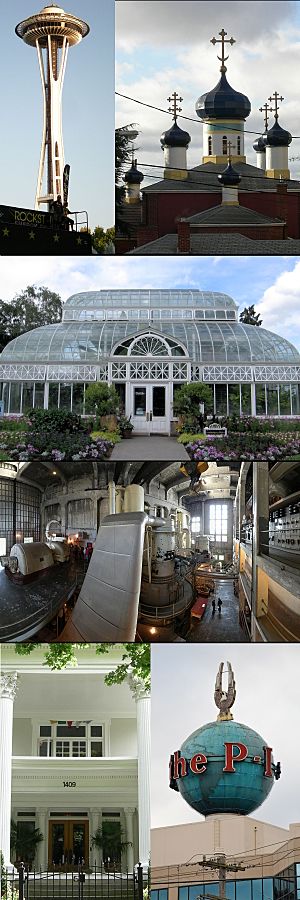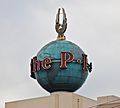Seattle Landmarks Preservation Board facts for kids

1. The Space Needle
2. St. Spiridon Russian Orthodox Cathedral
3. The Volunteer Park Conservatory
4. Inside the Georgetown PowerPlant Museum
5. A historic home at 1409 East Prospect Street
6. The P-I Globe
The City of Seattle Landmarks Preservation Board is a group that helps protect important historical places in Seattle, Washington. They work to save buildings, objects, and sites that tell a story about Seattle's past. The board suggests which places should be protected to the Seattle City Council. The council then turns these suggestions into city laws. This board is part of Seattle's Department of Neighborhoods.
The board has eleven members. The mayor chooses these members, and the city council approves them. The group must include experts like architects, historians, and engineers. As of 2025, more than 450 individual places in Seattle are protected as landmarks. These include buildings, vehicles, boats, and even street clocks!
Contents
Why We Protect Seattle's History
How the Landmarks Board Started
The Landmarks Preservation Board began in 1973. This was a time when many people in Seattle and other cities realized how important it was to save old buildings. In 1966, the United States government passed a law called the National Historic Preservation Act. This law helped protect historical sites across the country.
In Seattle, groups like Allied Arts and people like Victor Steinbrueck worked hard. They wanted to stop plans that would change historic areas like Pioneer Square and Pike Place Market. Because of their efforts, these two areas were named "historic" by the city in 1970 and 1971. After that, Seattle created the Landmarks Preservation Ordinance. This law set up the Landmarks Preservation Board to continue this important work.
What Are Seattle's Landmarks?
Individual Landmarks and Historic Districts
Seattle protects many individual landmarks. These can be single buildings, objects, or sites. But Seattle also has eight special "historic districts." These are larger areas with many historic buildings that together tell a story.
Some of these districts include:
- Pioneer Square: This neighborhood is one of Seattle's oldest. Many buildings here were built right after the Great Seattle Fire in 1889.
- International District: This area is the historic home for Seattle's Asian and Pacific Islander communities. Many buildings here date back to the early 1900s.
- Pike Place Market: This famous public market started in 1907. It still has some buildings that are even older.
- Ballard Avenue and Columbia City: These were once separate towns that Seattle grew to include.
- Fort Lawton (in Discovery Park) and Sand Point (in Magnuson Park): These were old military bases.
- Harvard-Belmont: This district has some of Seattle's most beautiful old homes.
How a Place Becomes a Landmark
The Landmark Designation Process
For a building, object, or site to be considered a landmark, it must be at least 25 years old. This age limit is actually lower than in many other big cities. Anyone can suggest a potential landmark by filling out an application. A city officer then checks if the application is complete. Once a place is nominated, you need special permission to make changes to its important features.
The board holds public meetings to consider all complete nominations. They look at six main reasons why a place might be a landmark. Only one of these reasons needs to be true for a place to be chosen:
- It's connected to an important historical event.
- It's connected to an important historical person.
- It shows a significant part of the community's culture, politics, or economy.
- It has special architectural style or construction methods.
- It's an amazing example of architecture or design.
- It's a clear visual feature that helps define its neighborhood or the city.
If the board agrees to consider the nomination, they schedule a second public meeting. This meeting happens 30 to 60 days later to make a final decision. If a place is chosen as a landmark, the board works with the owner to create an agreement. This agreement explains what features must be protected and how changes can be made. It can also offer benefits to the owner.
The city council must pass a special law to make landmark status official.
What Landmark Status Means
Rules and Rewards for Landmarks
The goal of the landmarks program is to "manage change, not to eliminate it." This means they want to keep the historical look and feel of a place while still allowing it to be used. For some buildings, only the outside is protected. For others, the inside is protected too.
If a building is a landmark or in a historic district, you need a "Certificate of Approval" to make certain changes. This includes changing the outside, adding signs, or even changing the paint color.
Being a Seattle Landmark is different from being listed on the National Register of Historic Places (NRHP). The NRHP is mostly about honor and doesn't stop owners from changing their property. Seattle's landmark status has real rules.
However, Seattle Landmark status also offers benefits! For example, the city might allow a landmark building to be used in a way not usually allowed in that area. They might also change rules about open space or parking. Owners of downtown landmarks can also transfer certain development rights. Plus, "special valuation" can delay property tax increases for up to ten years if a historic building is fixed up. These benefits are much more helpful than those from just being on the NRHP.
Who the Board Cannot Control
Limits on Authority
The Landmarks Board does not have power over all buildings. For example, some buildings owned by other government groups are exempt. The Metropolitan Tract in Downtown Seattle is owned by the University of Washington. Because of this, the Landmarks Board cannot make decisions about those buildings.
Images for kids
-
Terracotta detail, Arctic Building. The walrus's current tusks are plastic for safety.
-
Ornamental grating, Seattle Times Building, 1120 John Street (South Lake Union)
-
The Montlake Bridge, a landmark along with the Montlake Cut it crosses.













